
It was the winter of 1958. I was 15 and living in the South. There was a new kid in town, a young woman who would change the history of public school education.
In addition to being Black History Month, this February marks the 64th anniversary of the integration of public schools in Virginia. I was a sophomore in a Norfolk, VA high school when Governor J. Lindsay Almond, Jr. closed the state’s public schools rather than obey a federal integration order.
The Virginia State Legislature had empowered the governor to close any public school that was “threatened” by integration. On September 29, 1958, six of Norfolk’s formerly all-White schools were closed to avoid integration. During the semester that the schools remained shuttered, most of the students, like me, attended tutoring groups in local churches, organized by dedicated teachers, who would have been teaching in the schools under normal circumstances.
But circumstances were anything but normal that year in that city.
While many students enjoyed the less-than-disciplined environment of alternative schooling, a young woman named Betty Jean Reed spent that time in a rigorous study regimen at another church in another part of town. She became one of The Norfolk 17, a group of academically and personally outstanding Black students who would later desegregate the city’s schools.
On January 19, the State Supreme Court and the Federal District Court declared that the school closings in Norfolk were unconstitutional. Two weeks later, on February 2, 1959, the Norfolk 17 became the first African American students to attend the previously all-White schools in the largest school district in the state of Virginia. And Betty Jean became the first, and only, Black student at Granby High School.
On that cold winter morning, she walked past the National Guardsmen who lined the pathway to our high school, “in case there was any trouble.” All eyes, and TV cameras, were trained on her, as the other students, all White, filed soberly through the front doorway of the school that faced the street for which it was named.
Betty Jean walked, what must have seemed an endless road, into the school and past a long hall of lockers, her face reflecting a steady calm. There were no crowds cheering her on as she made history. Only a lot of people who had a stake in her failure.
However, Betty Jean successfully navigated that day and followed it with two and a half more years of grace. She not only made the cut, but graduated with honors marking Granby High School’s first integrated graduating class by her lone, and lonely, presence. I had the honor of graduating in that historic class, but she had the moxie to make it happen.
See Life magazine’s photos of Betty Jean and the Norfolk 17 here: https://www.life.com/history/brown-v-board-of-education-photos-of-integration-in-virginia/
Email [email protected] follow her on Twitter @patriciabunin
